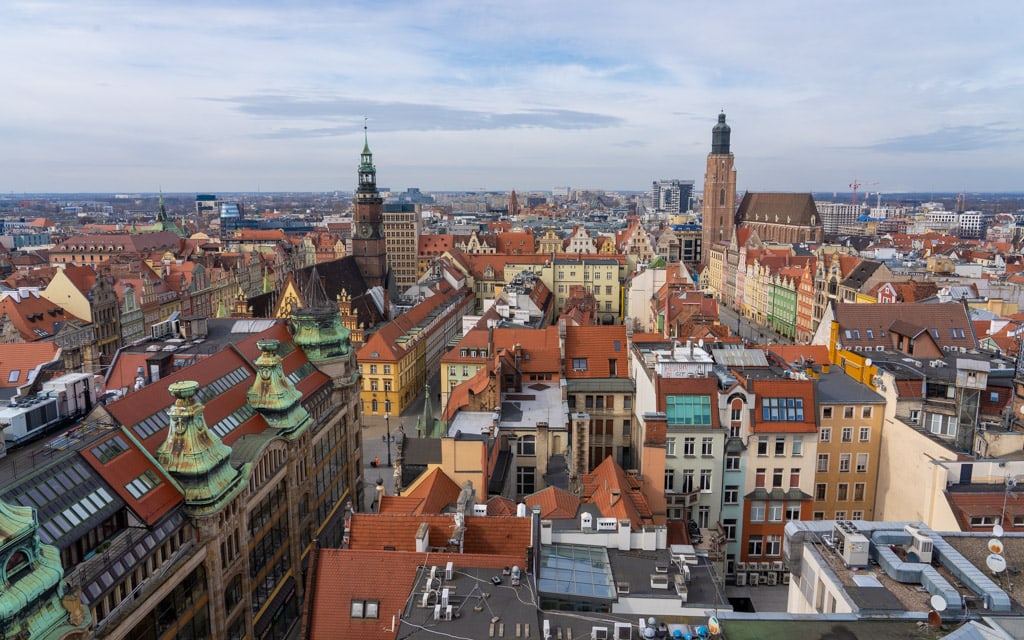
Wrocław is one of Poland’s great cities. While Warsaw and Kraków are better known with tourists, Wrocław, the historical capital and largest city of the Lower Silesian Voivodeship, is well worth a stop whether you have a couple hours or a couple days.
The history of Wrocław dates back over 1,000 years when a tribe settled on Ostrów Tumski, an island located on the Oder river. Over many turbulent centuries, Wrocław has been built up, invaded, destroyed, and ruled over by the Kingdom of Bohemia, the Habsburg Monarchy, and the Kingdom of Prussia, to name a few. Under German rule, the city was known as Breslau. During World War II, Breslau was damaged but survived as the city was far from the front lines. After the war, the city was handed back to Poland and renamed Wrocław.
Today, Wrocław is a unique and interesting mix of Bohemian, Austrian and Prussian influence. This influence can be seen from the architecture found around the city to its culture. In 2016, Wrocław was awarded as a European City of Culture.
So is Wrocław worth visiting and adding to your Poland itinerary? If you enjoy historical gems, a lively and colorful Old Town with Market Square (Rynek) at the heart of the city, and vibrant nightlife, then Wrocław is a must visit.
If you are looking for more information about Poland, I highly recommend you pick up a guidebook such as The Rough Guide to Poland
Table of Contents
How many days to spend in Wrocław?
You might be wondering, how many days should I spend in Wrocław? While this guide is geared towards travelers who have two full days in Wrocław, this itinerary can be modified for those who are on a day trip to Wrocław. Even if you only have a few hours in the city, you can visit most, if not all, of these sights listed below if you limit your time at each location. Go through this guide, pick and choose what works for you, and make a plan.
Arrival in Wrocław
If you are a tourist arriving in Wrocław, pronounced “vrots-wahf,” then chances are you will arrive by train at Wrocław Main Railway Station (Wrocław Główny) or by airplane at Copernicus Airport Wrocław (WRO).
Wrocław Main Railway Station (Wrocław Główny)
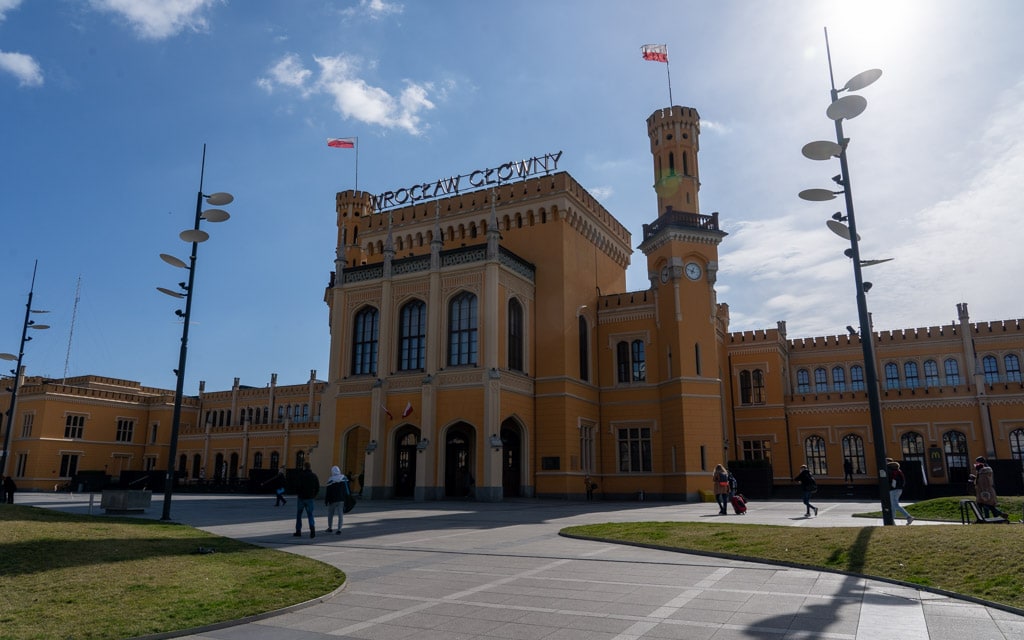
As mentioned before, if you are arriving in Wrocław by train, odds are you will arrive at Wrocław Main Railway Station (Wrocław Główny). This imposing and grandiose Neo-Gothic building, which was built between 1855 and 1857, is not your typical European train station. The station looks more like a palace or fort complete with turrets and battlements.
The station is located about 1.6 kilometers (1 mile) from the Market Square. With the station being located so close to the city center, you can walk to Market Square in about 20 minutes or you can reach it in less than 10 minutes by taxi or Uber.
If you have the time, I highly recommend a walk around the station where you can enjoy the elegant architecture of the building. Directly in front of the station is a public green space complete with benches and fountains.
If you need to store luggage, you will find luggage storage lockers at the station. Depending on the size of the locker, rates start at 13 zł and go up to 18 zł for 24 hours. Cash and credit cards are accepted. If paying in cash, be aware that only coins (1 zł, 2 zł, 5 zł) are accepted.
Copernicus Airport Wrocław (Port Lotniczy Wrocław im. Mikołaja Kopernika)
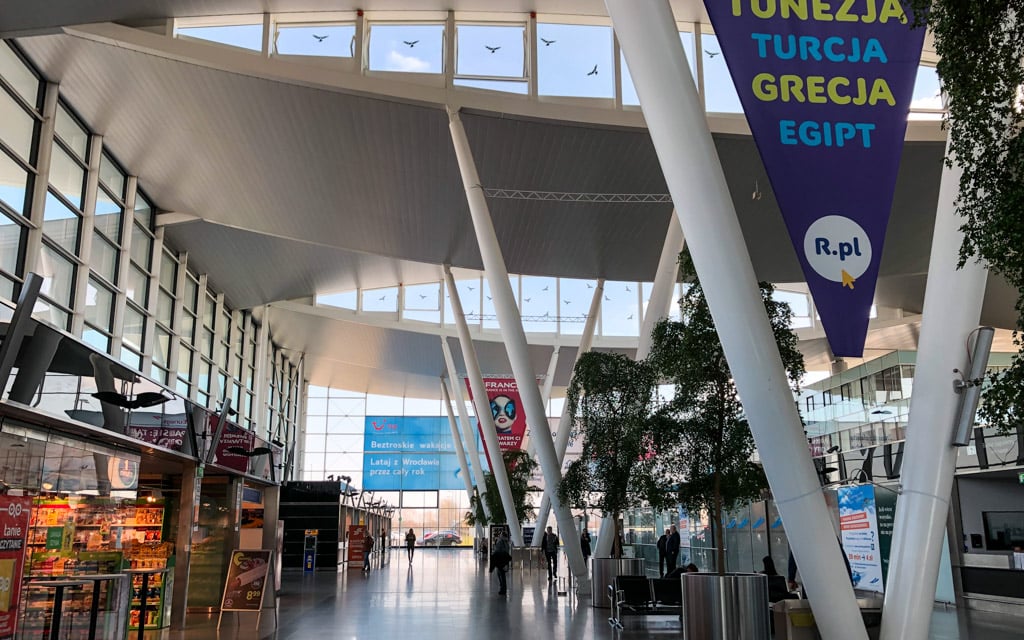
If you will be flying into Wrocław, then you will be landing at Copernicus Airport Wrocław (IATA airport code WRO). The airport is located about 10 kilometers (6.2 miles) southwest of the city center.
Copernicus Airport is a small airport with one runway and one passenger terminal, making it quick and easy to travel through when compared to larger airports in Europe. Major airlines that operate here include Air France, Eurowings, KLM, LOT Polish Air, Lufthansa, SAS, and Swiss Air.
If you do not have a car, then you have two main ways to reach the city center from Wrocław Copernicus Airport: bus or taxi/Uber. Currently, there is no train service.
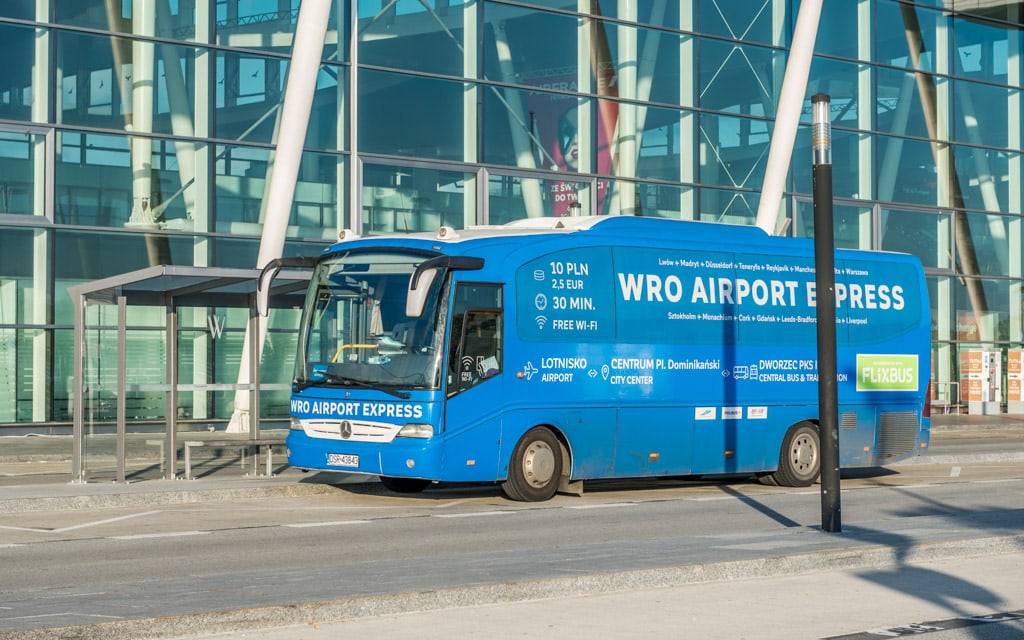
The first option is the WRO Airport Express bus. This bus connects the airport with Dominikański Square (Plac Dominikański), near Market Square, and with the Central Bus and Railway Station (Dworzec Wrocław). The journey, which takes about 30 mintues, costs 10 zł or 2.5 euros and can be paid for on the bus by cash or credit card. In addition, municipal Bus 106 and Night Bus 206 travel between the airport and the main train station. You can find more information about municipal buses at https://www.wroclaw.pl/en/transport-in-wroclaw.
If you are traveling in a group or prefer door-to-door transportation, then a taxi or Uber might be the best choice for you. A taxi from the airport to Wrocław city center will cost between 50 zł and 70 zł depending on your destination and traffic. If you are looking for a more affordable option, then I recommend taking Uber which will cost you around 30 zł to 40 zł.
Market Square (Rynek we Wroclawiu)
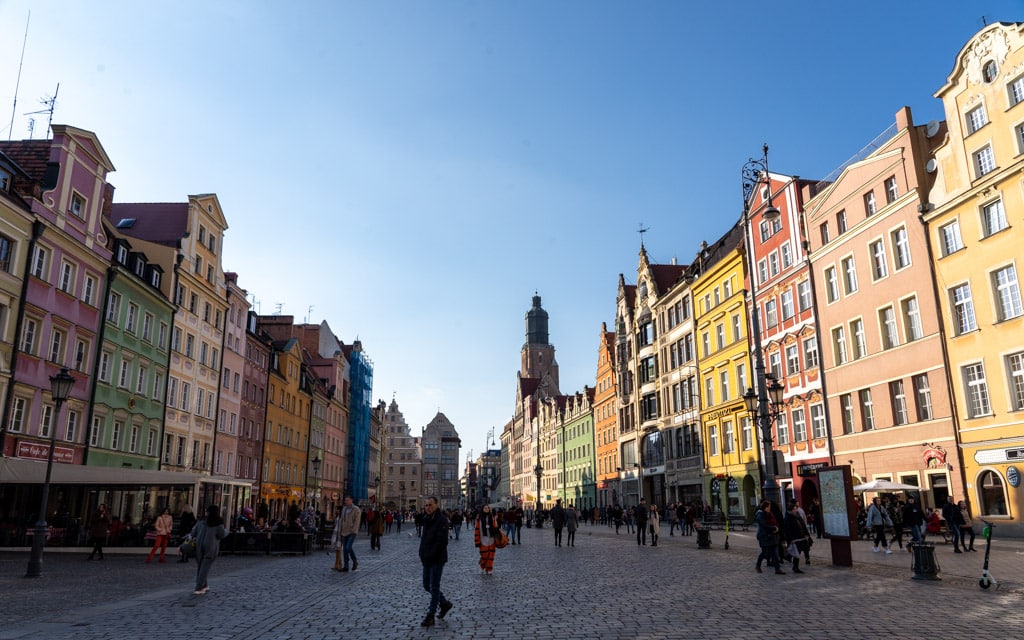
Located at the center of Wrocław is Market Square (Rynek we Wroclawiu). This medieval market square has been the historical heart of the city since the 13th century. At 213 meters by 178 metres (698 feet by 583 feet), Rynek we Wroclawiu is one of the largest medieval market squares in Europe. The largest medieval market in Europe is Rynek Główny, Kraków’s main market square.
Between the 13th and 14th centuries, wealthy citizens of Wrocław built houses surrounding the market square. By the middle of the 14th century, patricians’ houses surrounded the entire square, similar as to what we see today.
During World War II, much of Wrocław was destroyed. While the square was badly damaged, many of the surrounding buildings survived.
There are many important points of interest located in and around the square. To the southwest is Salt Market Square (Plac Solny), where a market operated from the Middle Ages to the 19th century. To the northwest is St. Elizabeth’s Church (Kościół Św. Elżbiety), a 14th century Gothic Roman Catholic church. One of the most beautiful buildings located on Market Square is the Old Town Hall, dating back to the 13th century. Adjacent to the Old Town Hall is the New Town Hall which was built between 1860 and 1864.
Old Town Hall (Stary Ratusz)
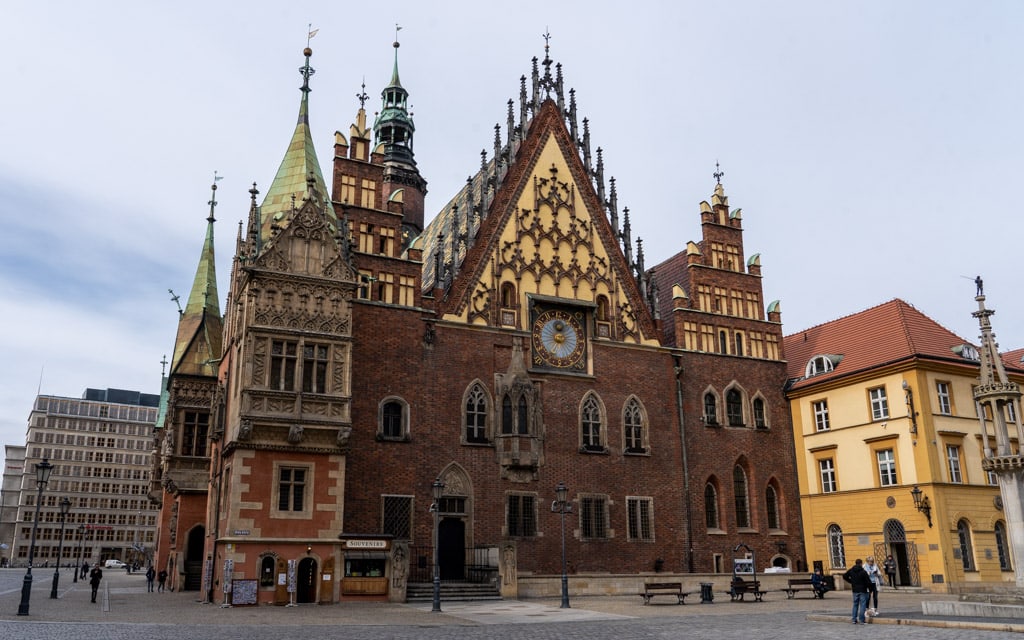
This Gothic building situated on the southern section of Wrocław’s Market Square is the Old Town Hall (Stary Ratusz). This landmark of Wrocław is one of the most impressive structures in the entire city.
Construction on the building started in the 13th century and continued for about 250 years into the 16th century. While the exact date construction started is unknown, the oldest parts of the building including Burghers’ Hall and parts of the tower are believed to date back to 1299.
Between 1328 and 1333, an upper story was added. Expansion continued throughout the 14th century with the addition of extra rooms including the Court room. Several more rooms were added from 1470 to 1510. In 1558, the upper portion of the 66 meter (216 foot) tower was rebuilt. By 1560, most of the construction was complete.
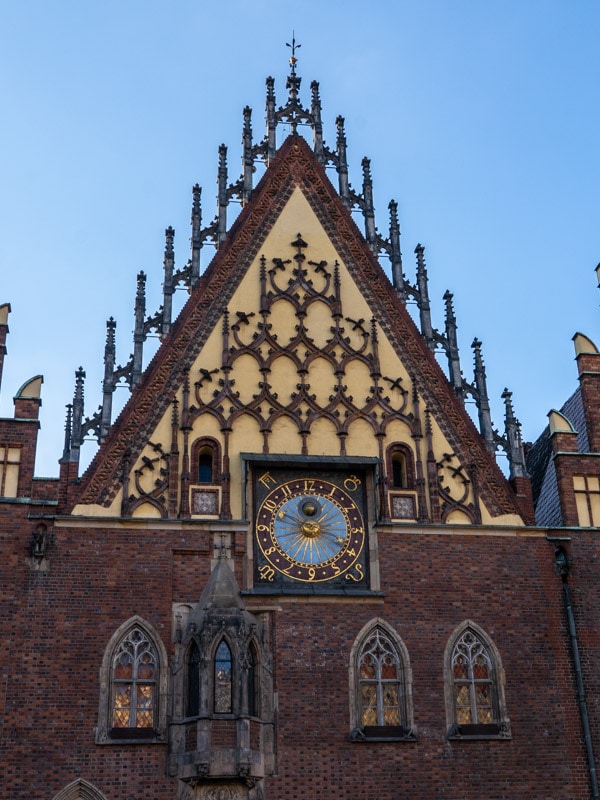
The 16th century eastern facade features a triangular roof adorned with pinnacles. In 1580, the clock seen on the eastern facade of the hall was installed. Made of wood and larch, this clock shows not only the time but the phases of the moon.
In the 1930s, the Old Town Hall was converted into a museum. During World War II, the structure avoided any major damage. An aerial bomb did land on the roof, but luckily, it did not explode.
Today, the Old Town Hall houses the Museum of Bourgeois Art. The building is also used for concerts along with civic and cultural events. In the basement of the hall is Piwnica Świdnicka, one of the oldest restaurants in Europe. Guests of the restaurant have included Holy Roman Emperor Sigismund, composer Frederic Chopin, and artist Pablo Picasso.
Salt Market Square (Plac Solny)
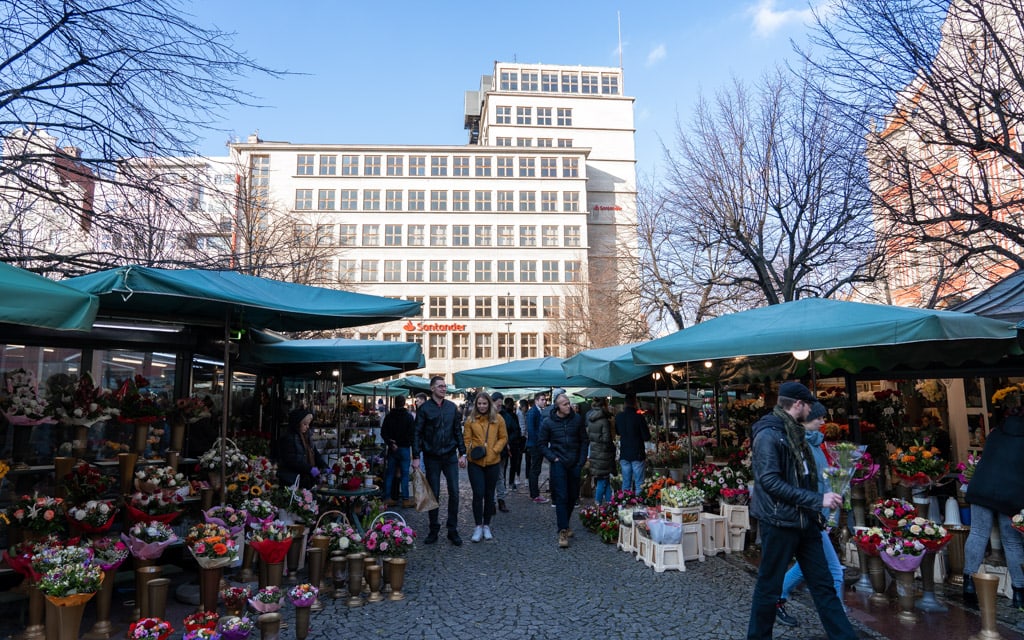
Located southwest of Market Square is a small square known as Salt Market Square (Plac Solny). Over the years, this square has been known as Polish Market (Polnischer Markt), Solny Square (Salzplatz), Salzring (Rynek Solny), and Blücherplatz in honor of Prussian field marshal Gebhard Leberecht von Blücher.
Salt Market Square most likely dates back to 1242 after the Mongol invasion of Poland destroyed much of Wrocław between 1240 and 1241. From the Middle Ages to the 19th century, goods, leather, honey, and salt from nearby Wieliczka Salt Mine were sold and traded here.
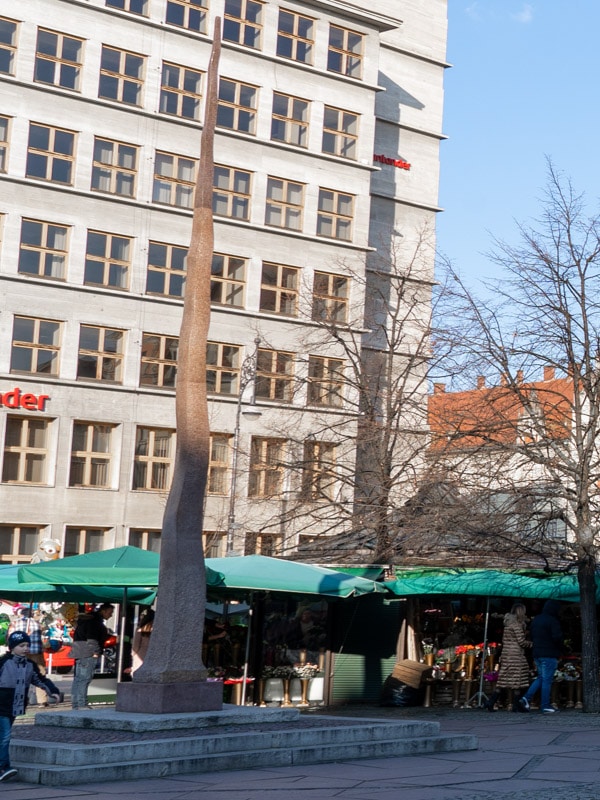
Located in the center of the square is a monument known as Small Spire (Małą Iglicą). This spire, which was completed in 1996, was designed by Wrocław sculptor Adam Wyspiański. The spire commemorates a time in Wrocław’s history when residents burned their valuables in the name of religion.
St. Mary Magdalene Church (Kościół Św. Magdaleny)
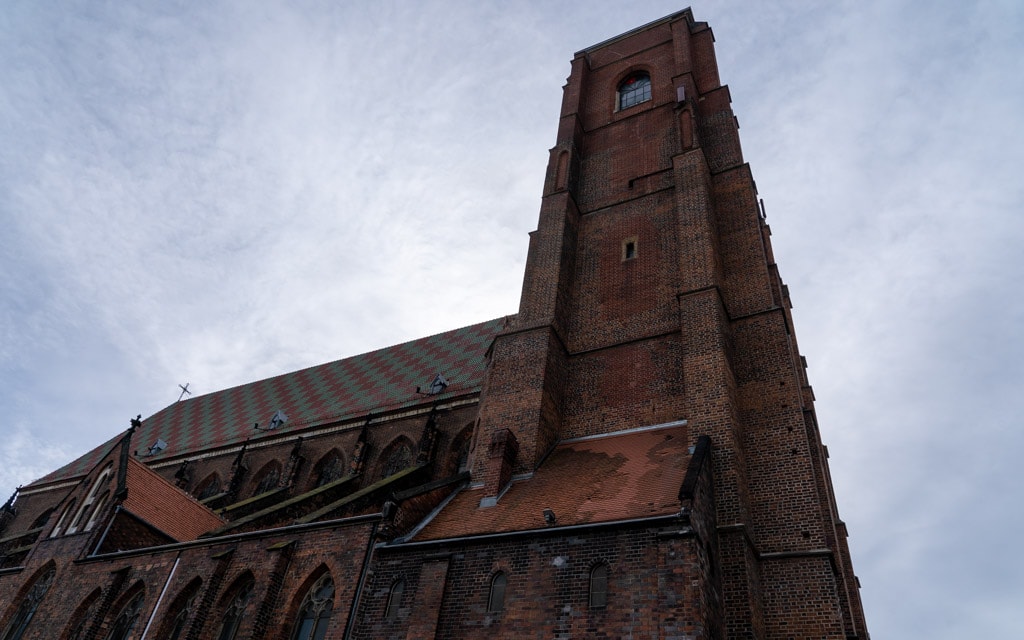
Located a block away from Market Square is St. Mary Magdalene Church (Kościół Św. Magdaleny), a massive red brick Gothic catholic church.
The first church to be built on this location was a Romanesque church built in the 11th century. This church was destroyed as were many others during the Mongol invasion of 1240 and 1241. Shortly after, between 1242 and 1248, a new church was built. A century later, this church was destroyed by a fire.
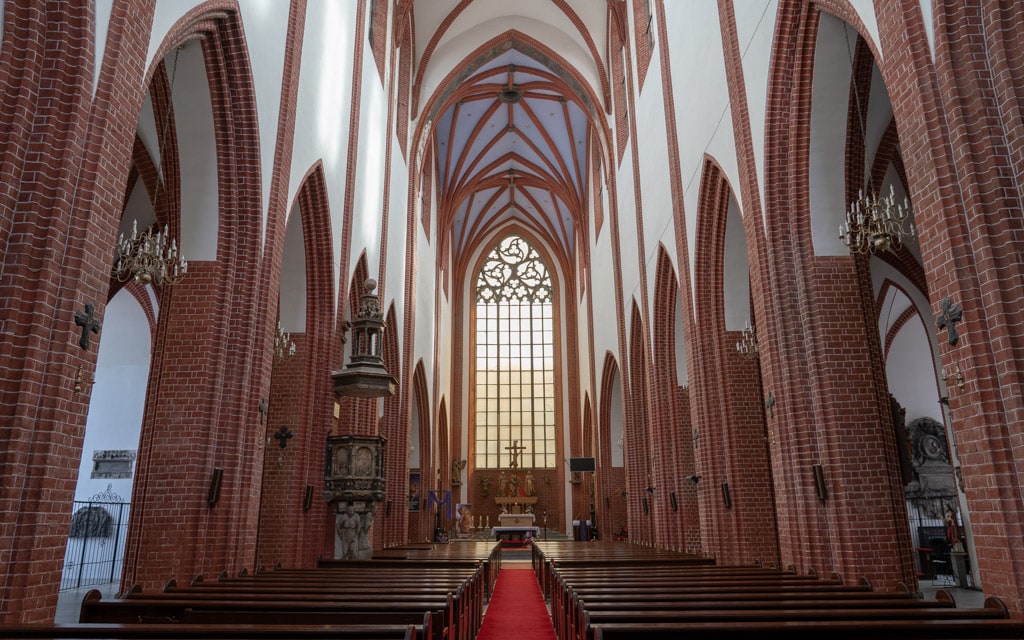
After the fire, a large Gothic church was built here. This church was built between 1342 and 1362. In the 15th century, the towers were completed. Over the next centuries, the church was improved, expanded, and rebuilt when necessary. During World War II, much of the church was damaged but the main structure survived allowing for its renovation from 1946 to 1977.
One of the most important features of this church is a copy of a 13th century Romanesque portal found on the south wall. This portal was moved from Benedictine Abbey in Ołbin in 1546 after the abbey was demolished.
Penitent Bridge
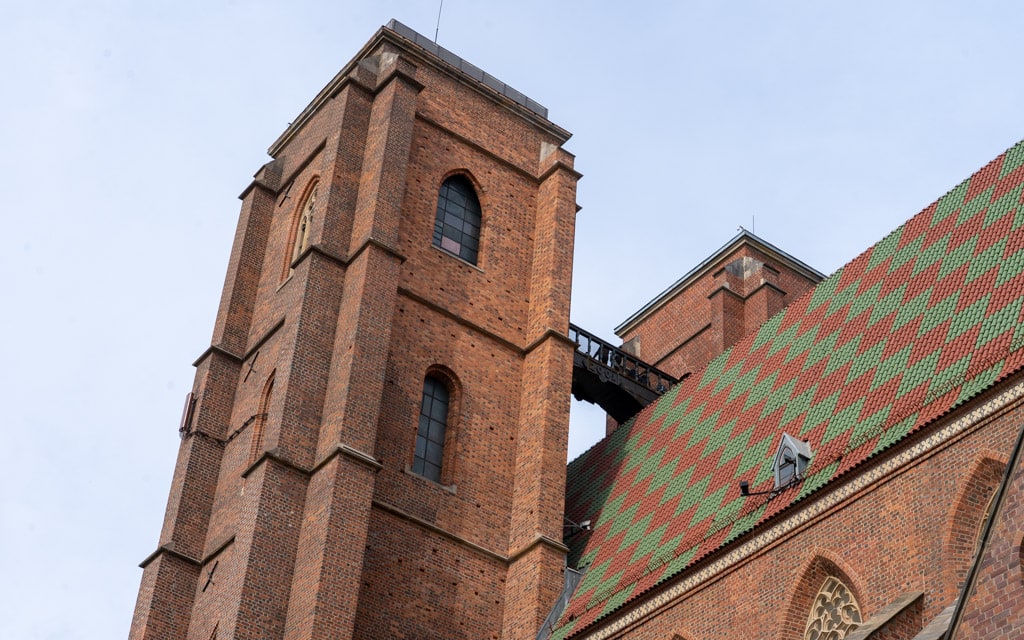
If you look closely between the two church towers, then you might notice a precariously located bridge. Spanning from one tower to the other, 47 meters (154 feet) above the ground, is a narrow footbridge known as Penitent Bridge (Mostek Pokutnic) or Witch Bridge. While the original bridge was built in 1459, the bridge seen today dates back to the 19th century.
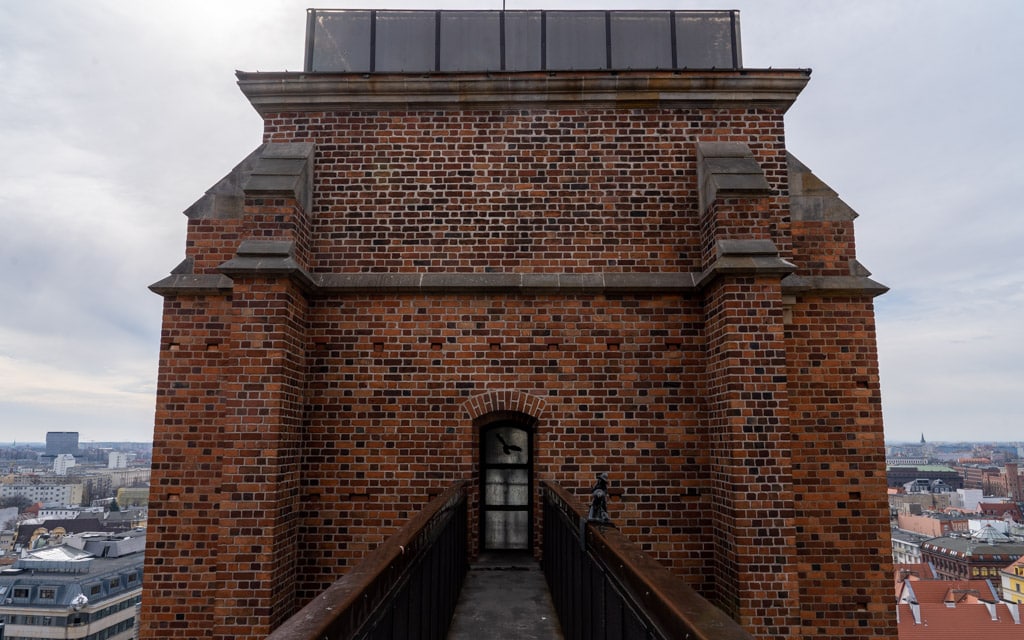
For centuries, the Penitent Bridge was used as a stage for special events, orchestras, and where fireworks were displayed for important events. Today, Penitent Bridge offers one of the best viewpoints of Wrocław.
Legend has it that the bridge is named after a young, beautiful woman named Tekla who would not listen to her father or mother about getting married. She was narcissistic and would flirt with men all day and do nothing with her life. For punishment, she was banished to the bridge where she was forced to sweep the bridge for eternity. The shadow of the woman could be seen from the ground, an ominous warning to all the other young women. Penitent Bridge was a place of penance for these women who chose a life of opulence over God.
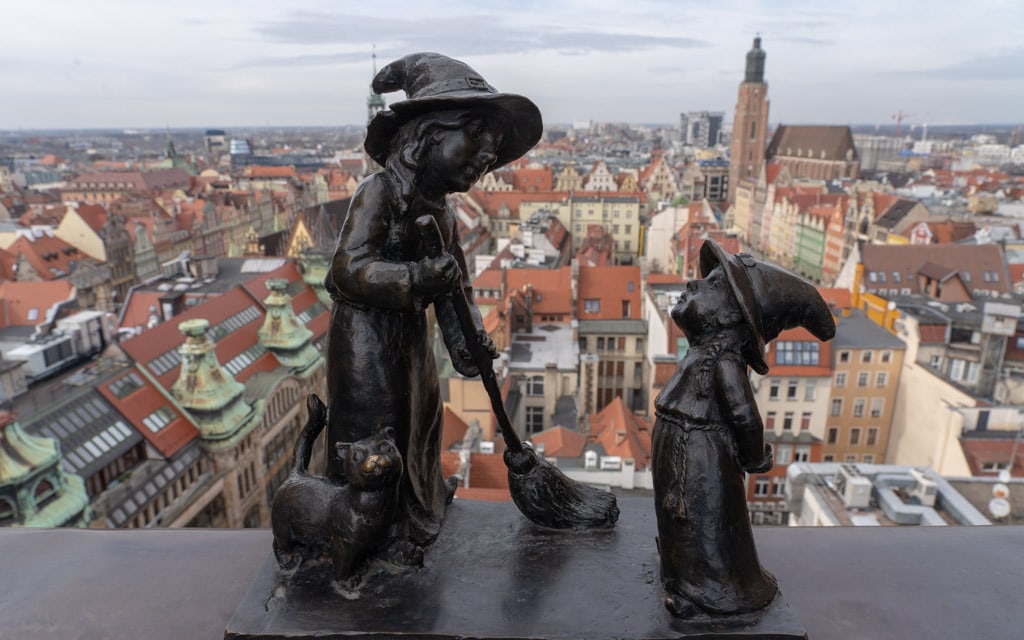
Penitent Bridge was also used to identify medieval witches. If you were accused of witchcraft, you were forced to walk across the bridge. Those who fell to their deaths before crossing the entire bridge were exonerated. Those who made it across the bridge were guilty as charged of being a witch. Their punishment? They were burned at the stake. This is why the bridge is also known as Witch Bridge.
If you want to reach Penitent Bridge, you will first have to buy a ticket for a small fee then climb about 300 stairs up the narrow tower to reach the top. While it takes some effort, the views from the top are well worth the trouble.
St. Elizabeth’s Church (Kościół Św. Elżbiety)
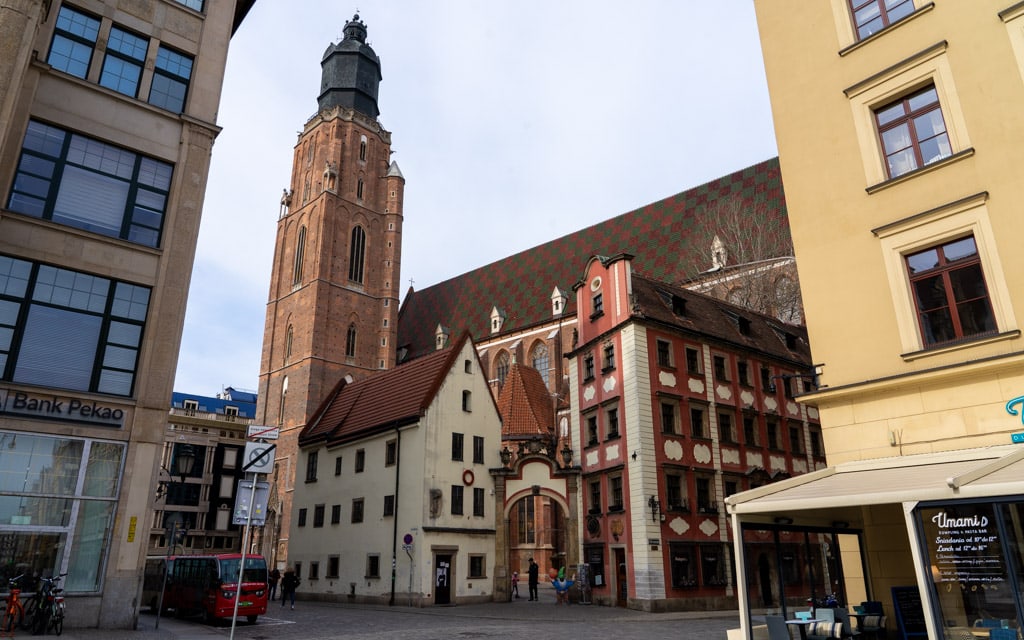
Located on the northwest corner of Market Square is St. Elizabeth’s Church (Kościół Św. Elżbiety), one of the most iconic Gothic structures in Wrocław. In 1946, the church was handed over to the Military Chaplaincy of the Polish Roman Catholic Church.
While a church has stood at this location since the 12th century, the current three-nave, nine-bay church as seen today dates back to the 14th century. Over the centuries, the church has been damaged and repaired. In 1529, the church was damaged during a hail storm. In 1976, a fire gutted much of the interior. During the fire, a famed organ was destroyed. During World War II, the church was damaged but survived.
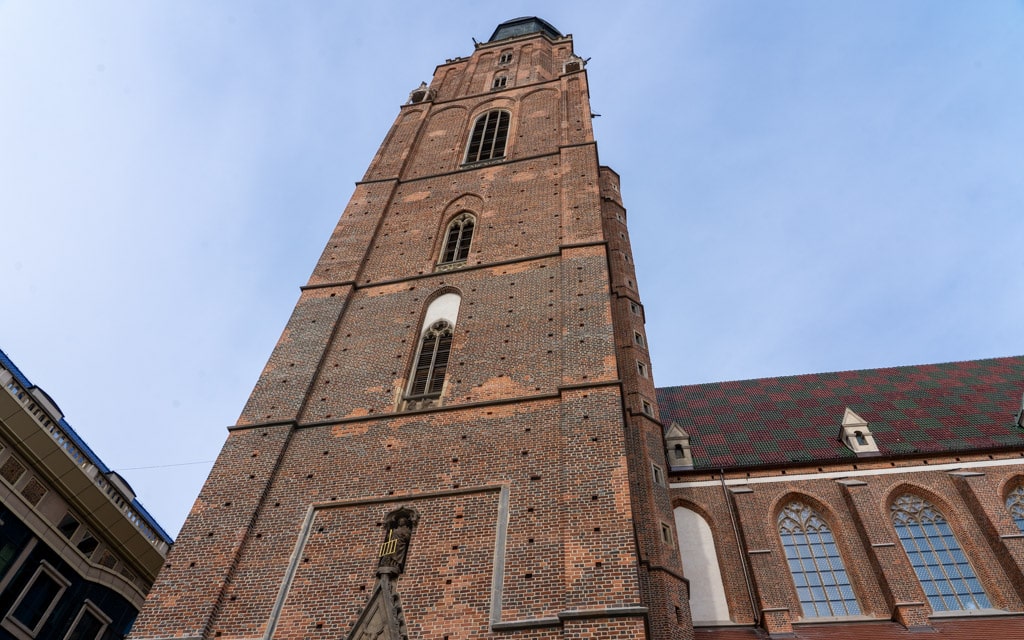
From 1525 to 1946, the main tower of St. Elizabeth’s Church measured in at 130 meters (426 feet). After reconstruction in the 20th century, the main tower was lowered to 91.5 meters (300 feet). Even after reconstruction, St. Elizabeth’s Church is the tallest structure in the Old Town. If you are a fan of viewpoints, be sure to climb the 300 steps up the tower where you will be rewarded with 360-degree views of Wrocław and the Old Town below.
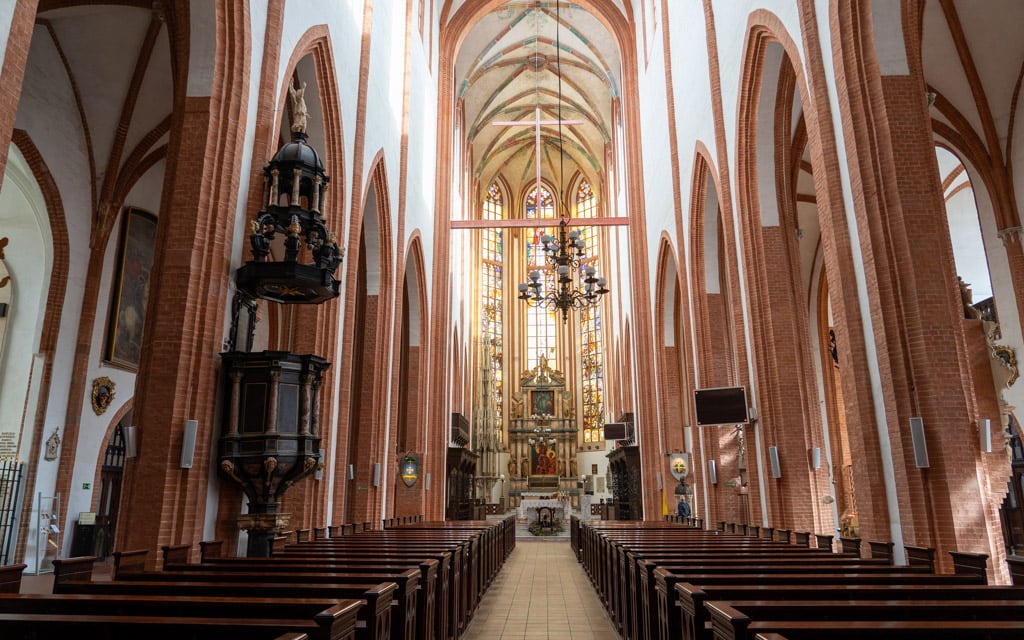
Inside the bright airy interior of the church you will find Gothic and Renaissance altars and stalls which date back to the 15th century. If you look at the ceiling above the nave, you will notice a unique feature of red and green tiles on the roof. Also resting here are the tombs of over 100 prominent citizens.
National Ossolinski Institute (Ossolineum)
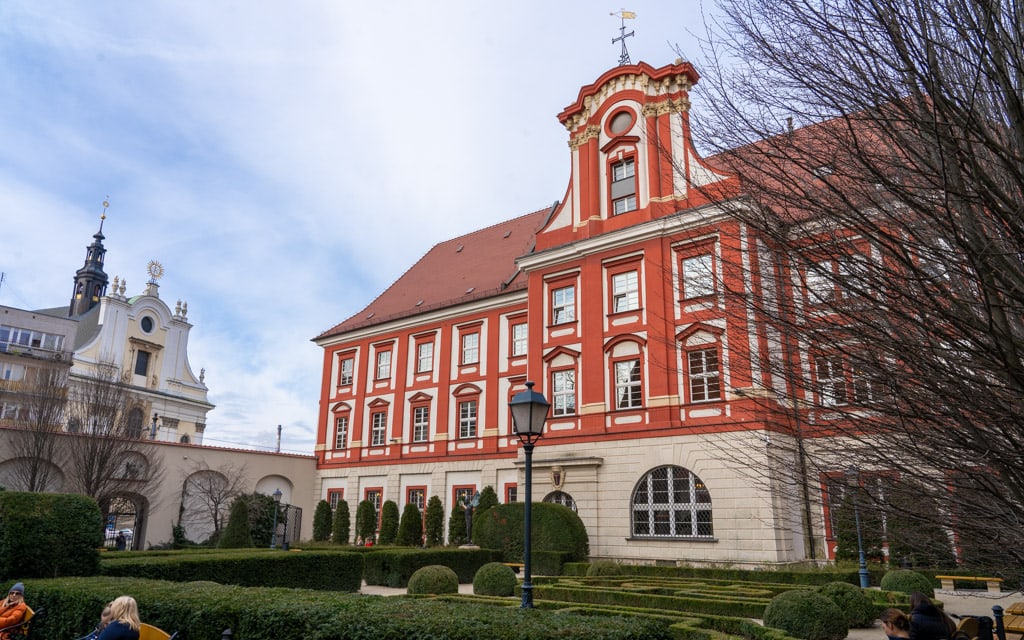
This Baroque complex located on the southern bank of the Oder river is the Ossolineum or National Ossolinski Institute (Zakład Narodowy im. Ossolińskich, ZNiO). The Ossolineum is an important scientific and cultural institution and research center of Poland. Its collections of over 1.8 million items, which is constantly growing, includes paintings, drawings, pictures, coins, medals, books, documents, journals, manuscripts, numismatics, maps, and more.
The Ossolineum was established by Józef Maksymilian Ossoliński in 1817 in Lvov in modern day Ukraine. Ossoliński (1748-1826) was a Polish nobleman, politician, historian, writer, and researcher who collected a large selection of books, manuscripts, prints, coins, and more. After years of collecting, Ossoliński opened an institute in Lviv which became a center of Polish culture and science. At the time, Lviv was part of Poland.
After World War II, the Soviet Union annexed Lviv. With control of the Ossolineum collections, Ukrainian authorities decided only to return certain materials back to Poland. In the end, the Soviets returned about 150,000 items or about 20% of the entire collection. The remainder of the collection remained in Lviv. Much of the collection was eventually destroyed by the Soviets as they wanted to erase Polish heritage and the history of Polish Lviv.
Today, the Ossolineum is one of the most important and largest scientific libraries in Poland. Its free exhibits are worth a visit if you have the time.
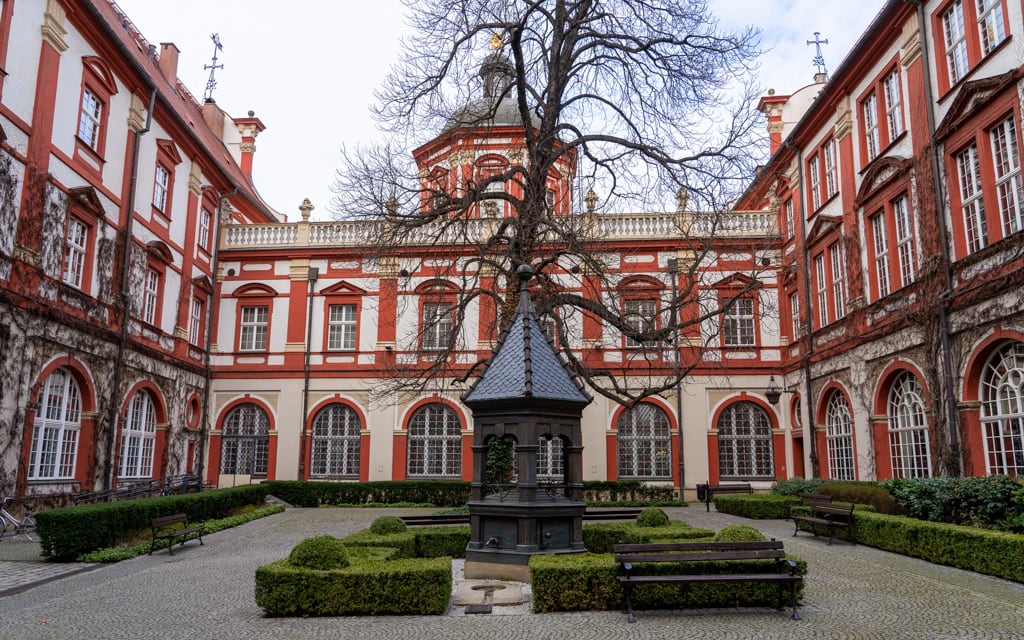
If your time is limited, be sure to stop by the monastery garden. This courtyard is one of the most beautiful places at the Ossolineum and a popular place for Wrocławians to rest and relax. During the summer, the courtyard holds events such as concerts and meetings. The courtyard also features a bust of the founder, Józef Maksymilian Ossoliński along with a small gazebo in the center.
Market Hall (Hala Targowa)
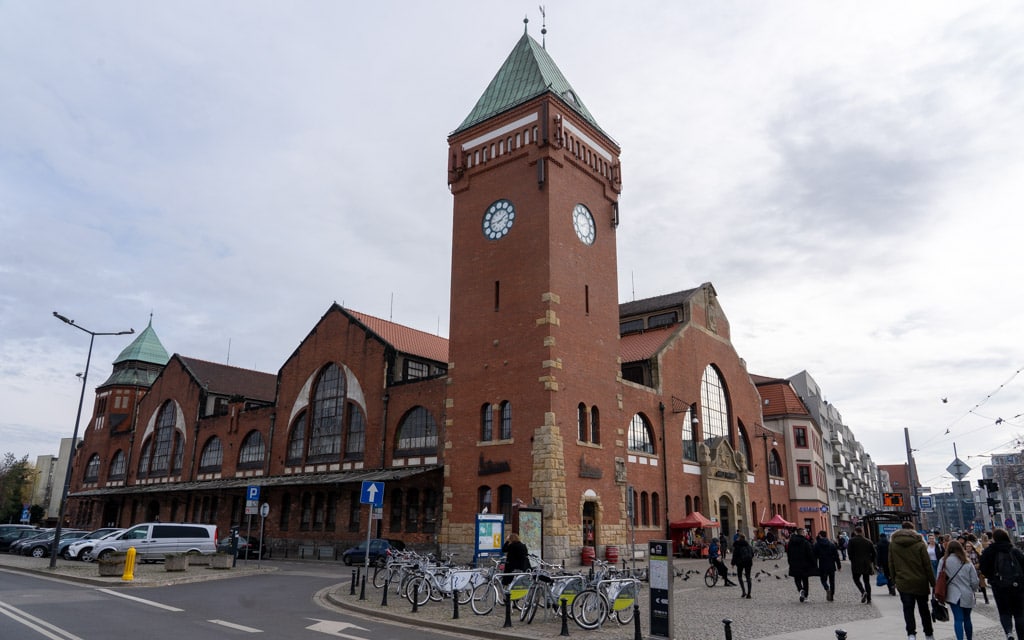
Located near the Sand Bridge (Most Piaskowy) on the Oder river is Wrocław’s Market Hall (Hala Targowa). This stylish market hall was built between 1906 and 1908 using the designs of Richard Plüddemann and Heinrich Küster. When Poland was occupied by Germany, the market was known as Breslauer Markthalle Nr 1.
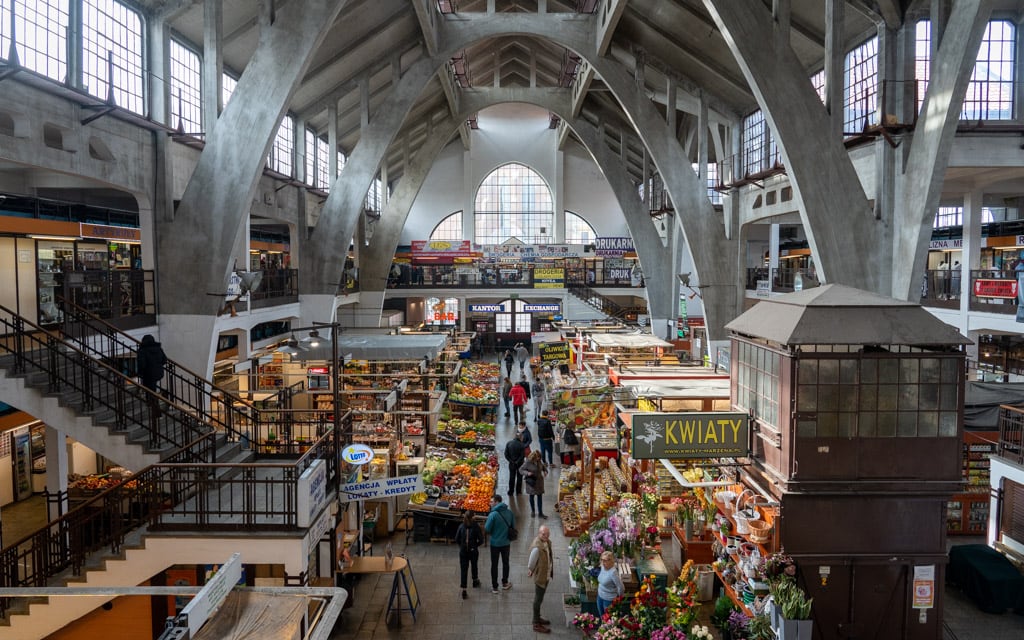
The simple yet striking facade of the neo-Gothic exterior, which is made of red bricks, is quite modern. The facade, with its two clock towers, along with the rectangular interior floor plan, was designed by Richard Plüddemann. Inside, the large, open interior features parabolic reinforced concrete arches. This innovative design, the first in Europe for a building this size, was designed by Heinrich Küster.
During World War II, the market hall was damaged but avoided total destruction. When the Soviets arrived after the war, they initially used the building as a stable. Soon after, the hall was reverted back to its original use as a market. Between 1980 and 1983, the market hall went through a major renovation.
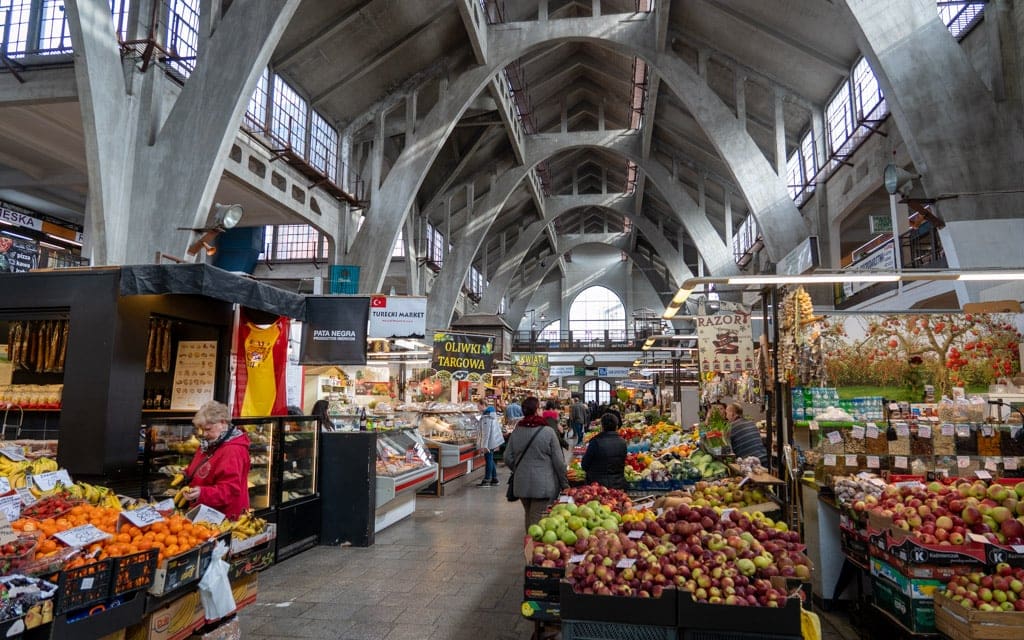
Today, Hala Targowa is one of the most recognizable markets in Poland. While the market is a popular tourist destination, it still operates as a functional traditional market visited daily by locals and restaurant owners looking for fresh goods from Poland and abroad.
On the bottom floor you will find an assortment of fresh foods including meats, fruits, vegetables, baked goods, cheeses, and more. There is also a large selection of fresh flowers for sale. On the second floor you will find more old fashioned items including souvenirs, toys, shoes, and glassware. If you are hungry, you will find a small pierogi bar popular with locals on the right hand side as you enter.
Looking for Polish craft beer? Stop by Targowa Craft Beer under the clock tower near the entrance.
Nawa Sculpture
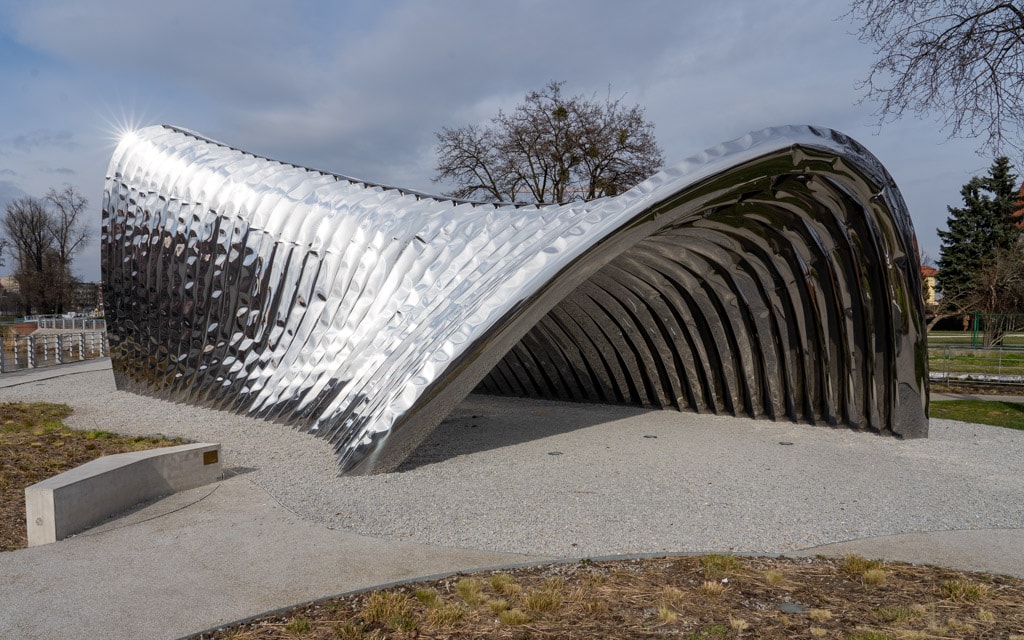
This futuristic looking metal sculpture, located on Daliowa Island (Wyspa Daliowa), the smallest island in Old Town Wrocław, is the Nawa Sculpture. The sculpture, which was unveiled in 2017, was designed by Polish architect Oskar Zięta.
Though located in the heart of Wrocław, tiny Daliowa Island was neglected for many years. After Wrocław was designated a European Capital of Culture by the European Union (EU) in 2016, the city started to revitalize the city. This plan included transforming Daliowa Island into a green area for concerts, art exhibits, and where locals and tourists could meet to socialize.
The highlight of Daliowa Island is the Nawa Sculpture. This shinny metal sculpture, which doubles as a tunnel, is constructed of 35 bionic steel arches. While it may appear simple, the technology to create the metal arches, which involved inflating sheet metal, was quite innovative. The arches of the sculpture were inspired by the shape of Daliowa Island along with the architecture of the National Ossoliński Institute (Ossolineum) and the churches found on Cathedral Island.
While a modern sculpture such as the Nawa Sculpture might seem out of place in Old Town Wrocław, its wavy surface and reflective metal blend into its surroundings. As you walk around and through the sculpture, notice how the metal reflects the surrounding buildings, trees, and the sky. The view will always be different depending on the hour of the day, the season, the weather, and where you are standing.
Tumski Bridge (Most Tumski)
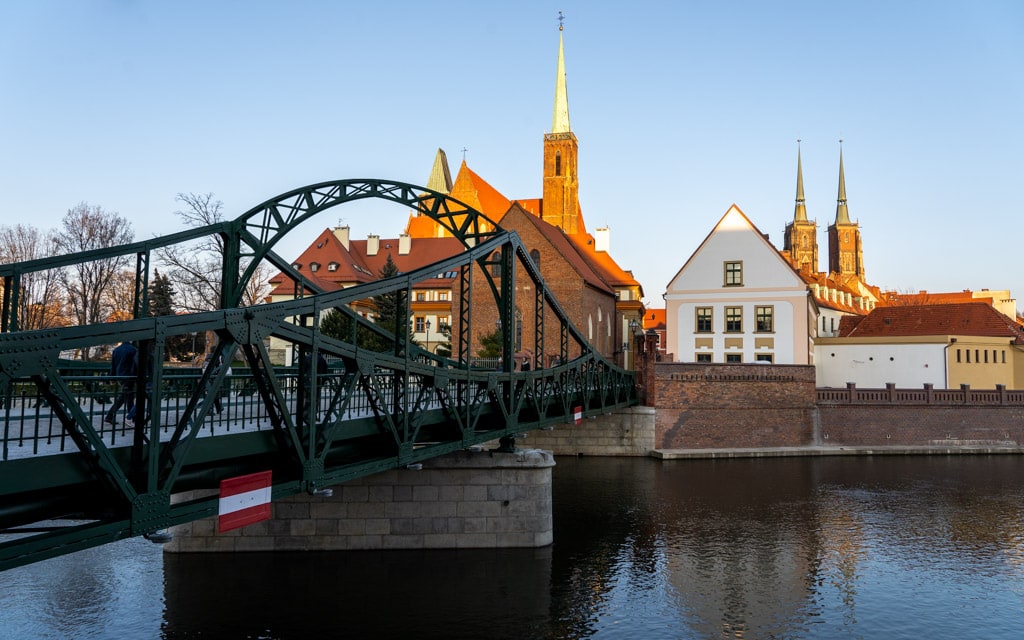
This steel bridge crossing the Oder river, which connects Cathedral Island (Ostrów Tumski) with Sand Island (Wyspa Piaskowa), is known as Tumski Bridge (Most Tumski). It is also called Cathedral Bridge, Lovers Bridge, and Green Bridge.
When Tumski Bridge was built in 1889, it replaced an older bridge. From 1889 until the end of World War II in 1945, Tumski Bridge was known as Cathedral Bridge (Dombrücke). In 1992, the bridge was renovated with much of its deck being replaced. Today, due to the age of Tumski Bridge, it is only open to pedestrians.
The bridge is also popular with lovers and couples. For many years, couples would attach “love locks” to the bridge, similar to Pont des Arts bridge in Paris. After, the key would be thrown into the Oder river below. Although charming to some, many consider these locks to be a form a vandalism. In recent years, the locks have been removed from Tumski Bridge and those trying to add new locks can be fined.
Cathedral Island (Ostrów Tumski)
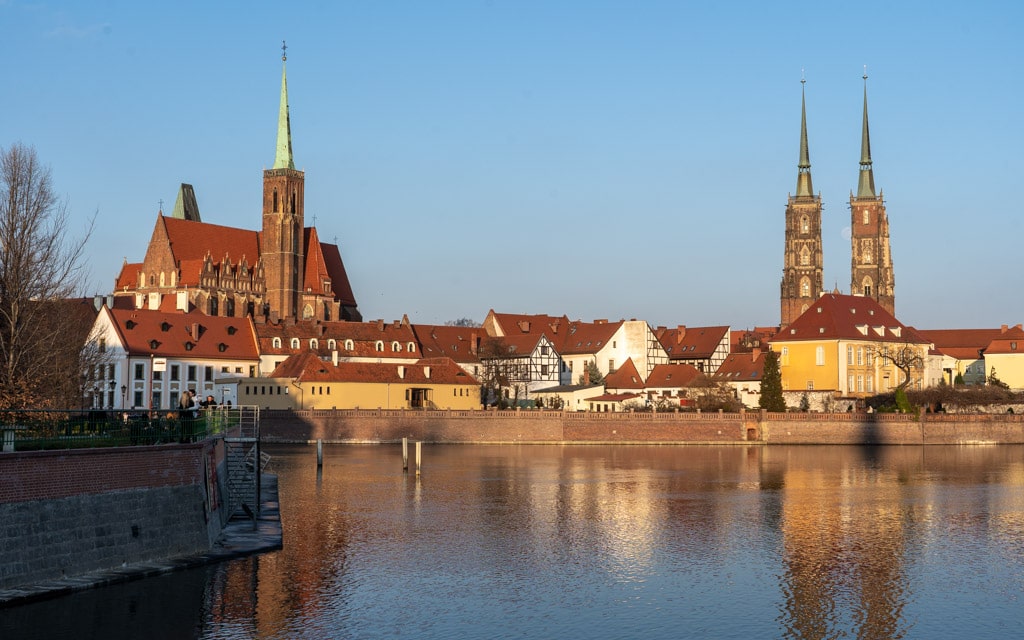
A fifteen minute walk northeast of busy Market Square will bring you to Cathedral Island (Ostrów Tumski), a quieter and older section of Wrocław.
Cathedral Island is actually not an island, at least not anymore. Up until the 19th century, Cathedral Island was an actual island located between multiple branches of the Oder River. Due to constant flooding, town planners decided to fill in one branch of the river, therefore connecting the island to the mainland.
This area is the oldest part of the city. It was here where Wrocław was founded over 1,000 years ago. The first occupants of Wrocław are thought to have inhabited the western side of the island near Tumski Bridge.
Today, some of Wrocław’s most important cultural icons can be found on Cathedral Island. This includes the Cathedral of St. John the Baptist and Collegiate Church of the Holy Cross and St. Bartholomew.
Wrocław Lamplighter
If you find yourself wandering around Cathedral Island at dusk, then you might stumble upon the Wrocław lamplighter, a charming man dressed in a black cape and top hat who carries around a long pole used to light lanterns. The job of the lamplighter, which is a highly respected profession, is to light all the lamps found on Cathedral Island (Ostrów Tumski) at dusk and extinguish these same lamps in the morning.
Before the 19th century, all lamps in the town used candles. In 1846, the first gas street lamp appeared on the streets of Wrocław. In the 1960s, many of these lamps were replaced with electrical bulbs. Fortunately, the 103 gas lamps on Cathedral Island, and the job of the lamplighter, survived this modernization allowing for this tradition to continue.
Cathedral of St. John the Baptist (Archikatedra św. Jana Chrzciciela)
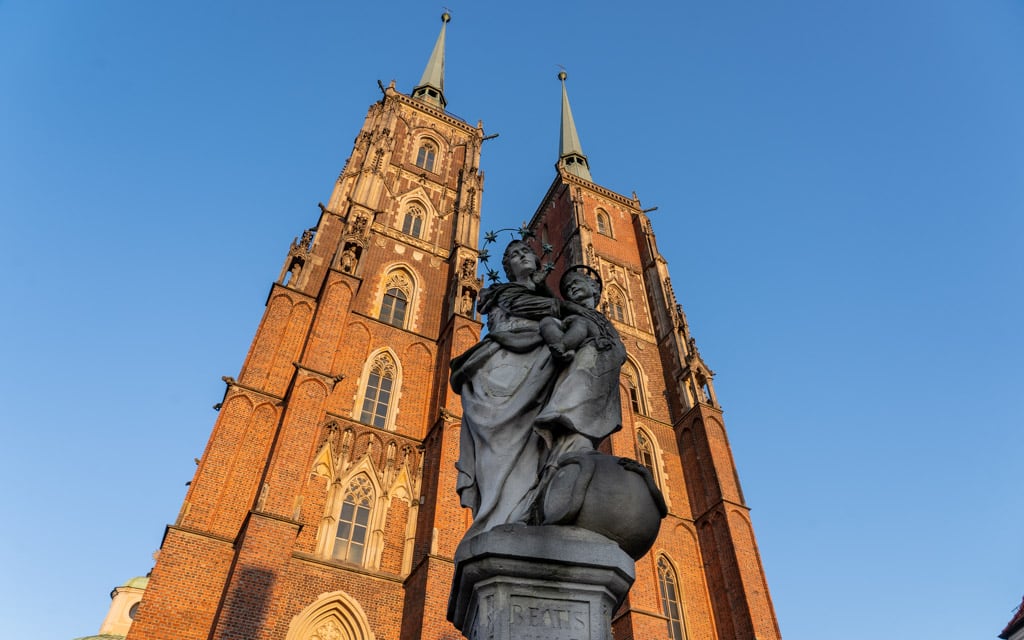
The highlight of Cathedral Island (Ostrów Tumski) is the Cathedral of St. John the Baptist (Archikatedra św. Jana Chrzciciela). Also known as Wrocław Cathedral, this church is an icon of Wrocław.
The church you see today is actually the fourth version that has been built on this site. The first church was built here in the mid 10th century and was destroyed around 1039. Soon after, a Romanesque-style church was built in its place. During the Mongol invasion of 1241 and 1242, this church was destroyed. Another church was built in the present-day Brick Gothic style. When completed, this was the first brick structure in the city. Over the next centuries, the church was damaged and restored many times. During World War II, the church was once again damaged. After the war, and up until 1991, much of the church was restored.
If you have the time, peak inside the three-nave basilica to view its rich, Gothic interior featuring 21 chapels along with an assortment of statues and paintings. The high alter features a 16th century gold and silver triptych of Virgin Mary from nearby Lubin. The church is also home to the largest organ in Poland.
One of the most iconic features of this iconic church are the towering double-spires that rise 91 meters (298 feet) into the sky. These spires can be seen from all around the city. As with many churches in Wrocław, for a small fee you can climb to the top of the tower for a panoramic view of the city below. The best part? You don’t have to climb. Visitors can use the lift, quickly taking them to the top of the tower without any sweating.
Wrocław’s Dwarfs (Krasnale)
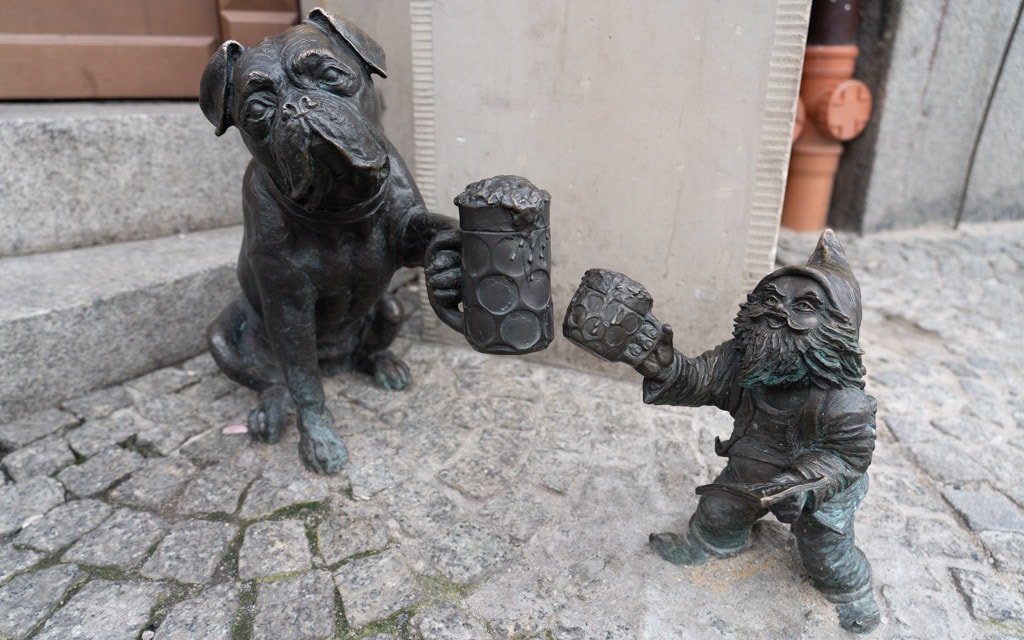
Take a walk around Wrocław and you are bound to stumble upon many of the more than 350 small figurines scattered around the city. These figurines are known as Wrocław’s Dwarfs (Krasnale) or Wrocław’s Gnomes.
The first dwarfs started appearing on the streets of Wrocław in August 2005. The first five dwarfs were created by Tomasz Moczek, a graduate of Wrocław’s Academy of Art and Design.
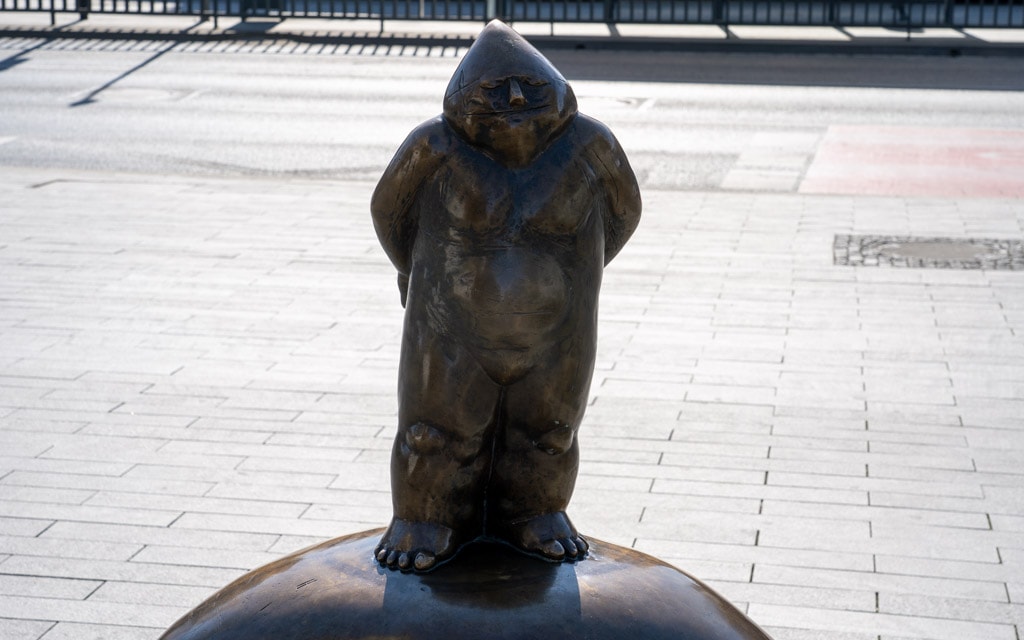
The history behind these dwarfs is somewhat more serious than you would think. In 2001, a dwarf monument, known as Papa Dwarf (Papa Krasnal), was erected on the corner of Świdnicka and Kazimierza Wielkiego streets, just south of Market Square. This monument commemorated the Orange Alternative, a Polish anti-communist underground movement which was started here in the 1980s. The symbol of the movement was a dwarf.
Today, there are over 350 dwarfs scattered around the city which have become popular with tourists. If you want to hunt down all of Wrocław’s Dwarfs, stop by the tourist office to grab a “dwarf map” so you can find them all.
The Anonymous Pedestrians
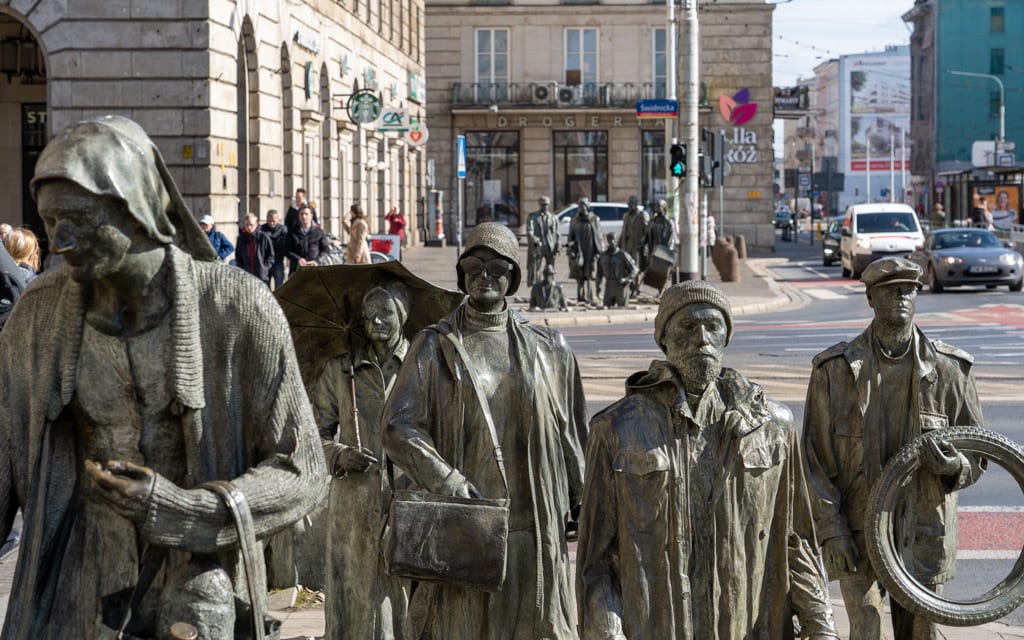
Located just south of the historic Old Town center, not far from Wrocław Main Station (Wrocław Główny) is a moving collection of sculptures known as The Anonymous Pedestrians or Passage (Przejście). These sculptures were created by Polish artist Jerry Kalina in 2005, marking the 24th anniversary of martial law in Poland.
On December 13, 1981, the Polish People’s Republic enforced martial law on its citizens. During this period everyday activities were controlled by the authoritarian communist government. Curfews were enforced, censorship was placed on all media, and travel was restricted. The main purpose of the martial law was to suppress democratic opposition and anti-government organizations including the Solidarity Movement which used civil resistance to advance workers’ rights and social change. During this period, many citizens and leaders were detained, arrested, and killed. While martial law ended on July 22, 1982, many political prisoners were never seen again.
On one side of the street is a group of seven ordinary men and women who appear to be sinking through the pavement. This group represents those who experienced martial law in Poland. During this period, citizens went into hiding, were arrested, or disappeared.
On the other side of the street is a different group of men and women who appear to be rising out of the pavement. This group represents Polish citizens rising up from martial law.
Today, this thought proving statue has gained international notoriety. Newsweek described it as one of the most beautiful places in Poland while American Budget Travel labeled it as one of the most remarkable places in the world.
Last Updated on July 8, 2025
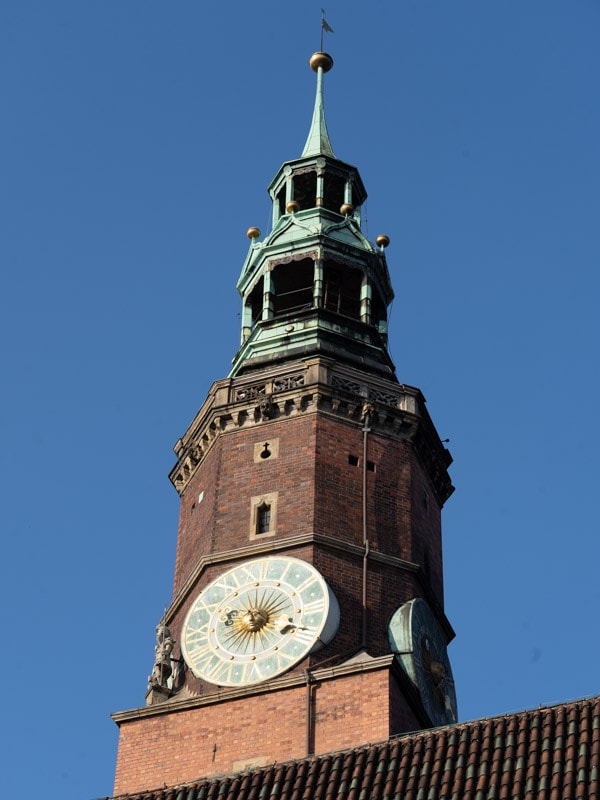
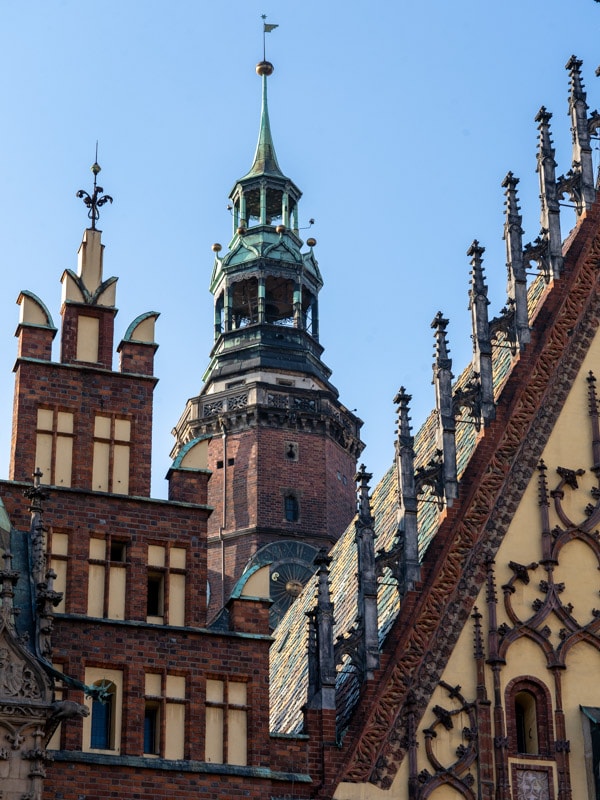
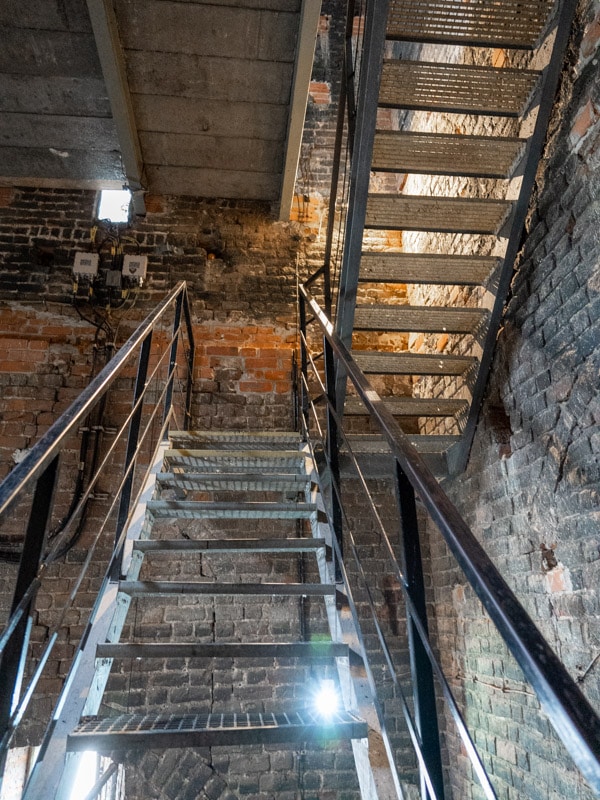
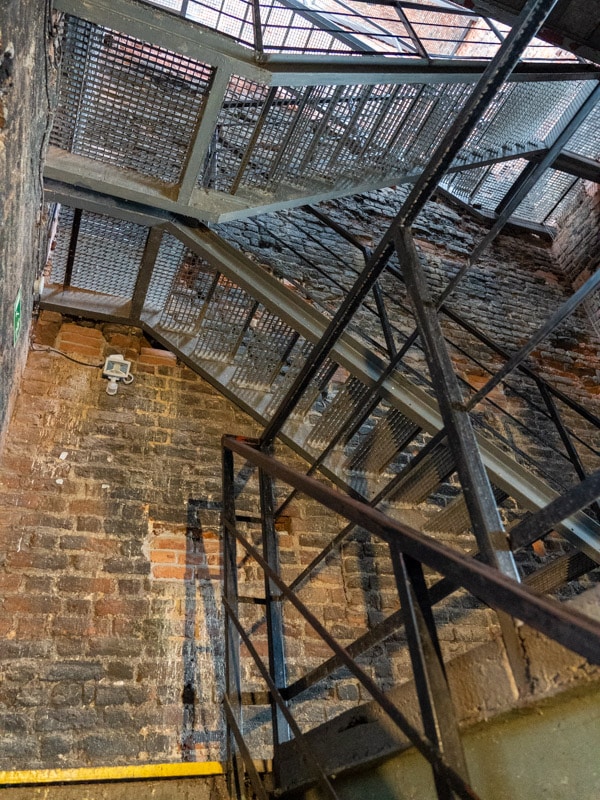
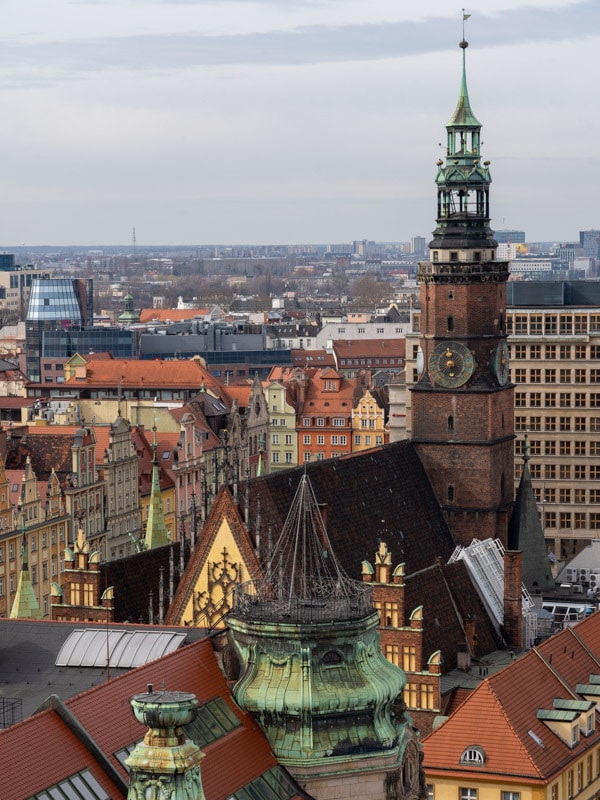
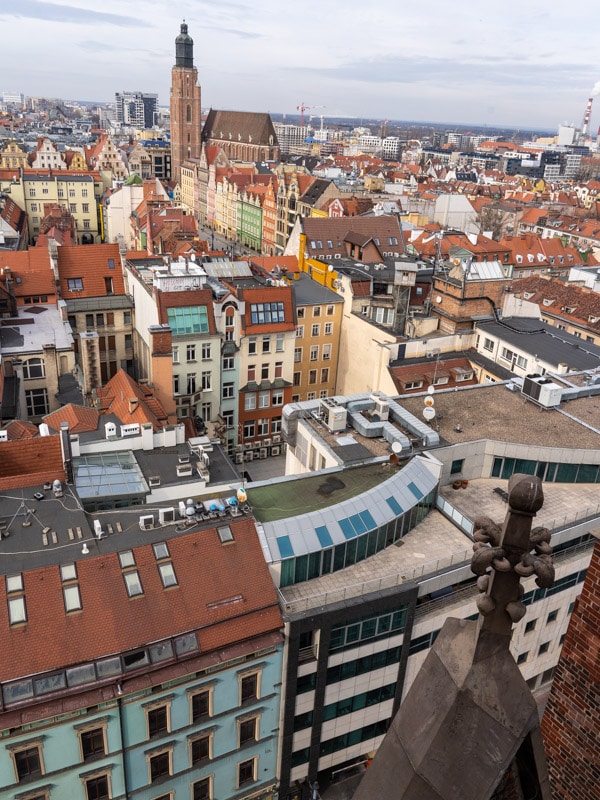

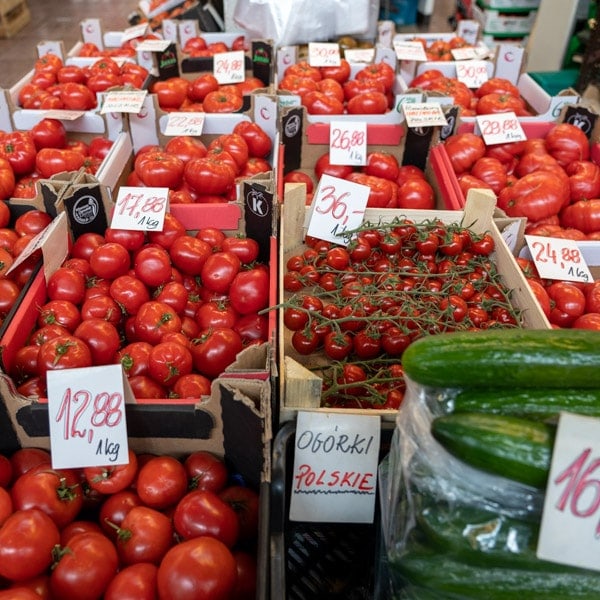
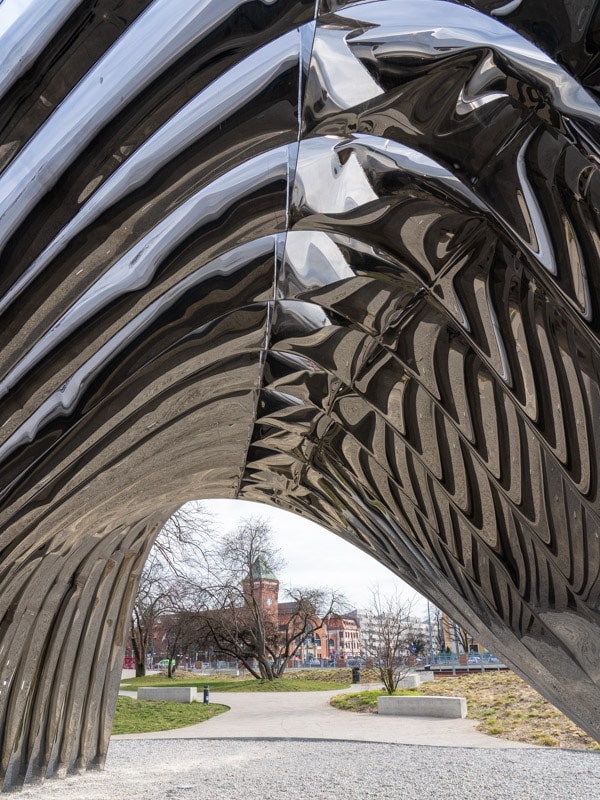
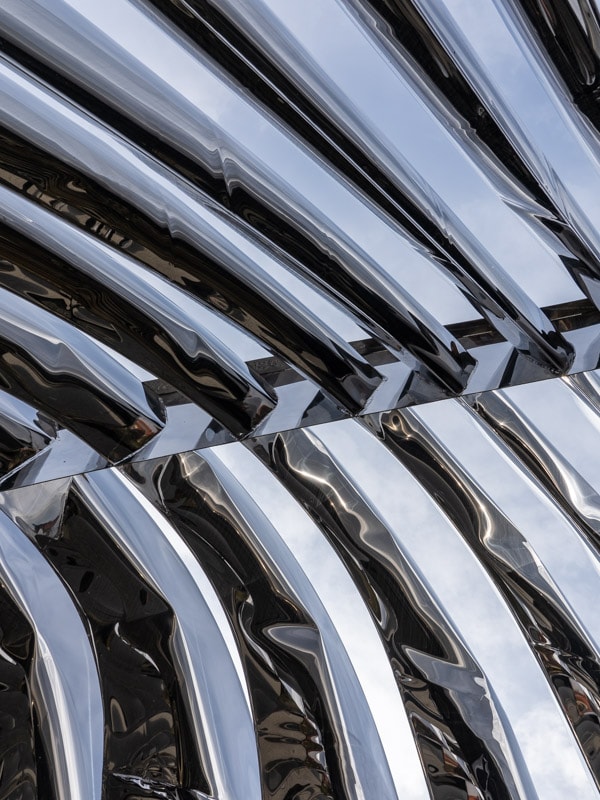
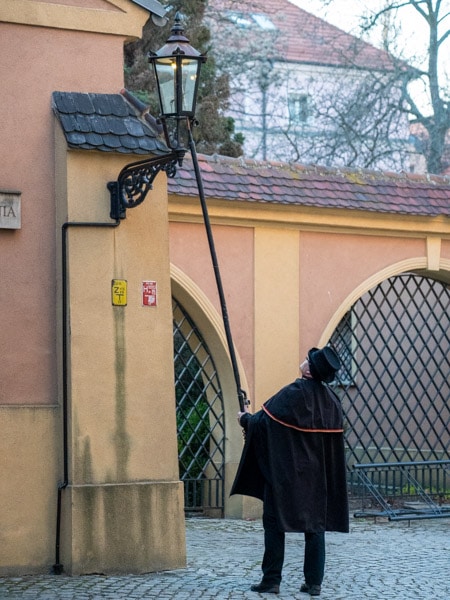
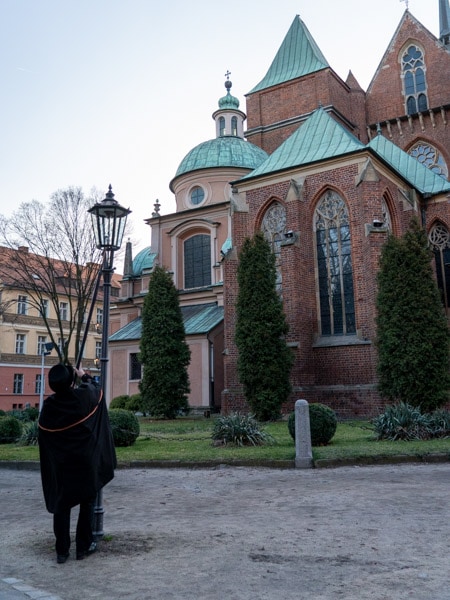
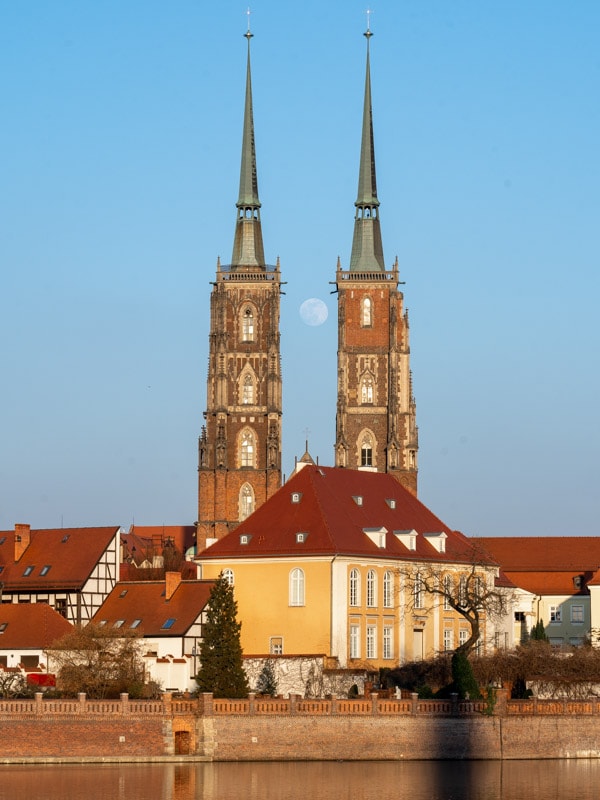
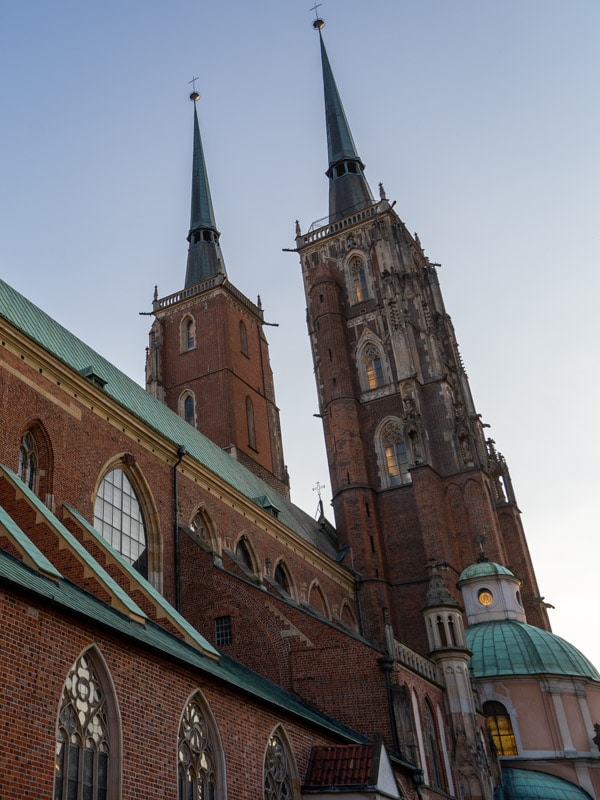
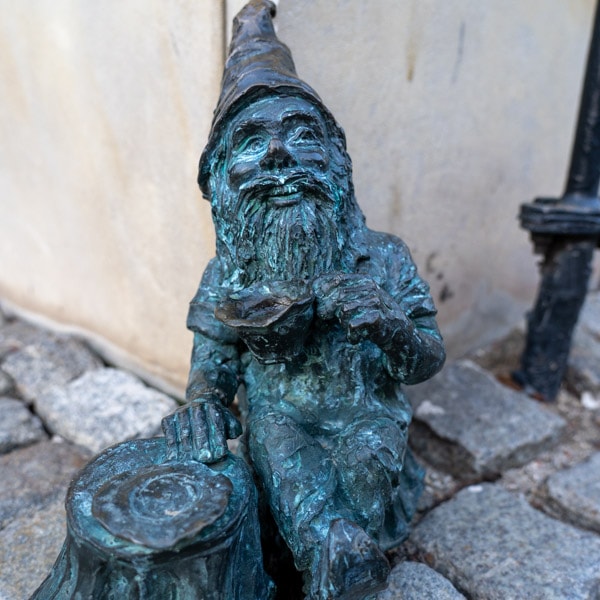
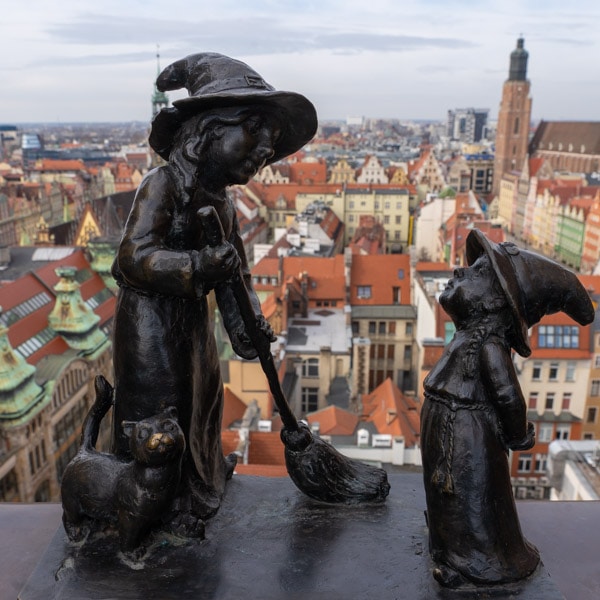
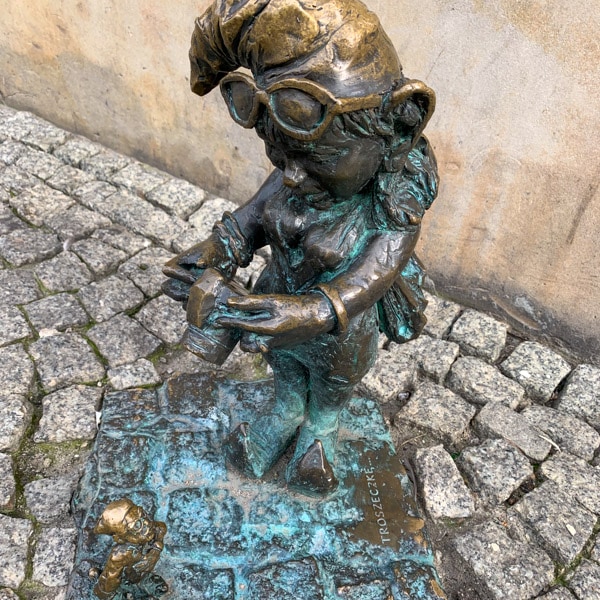
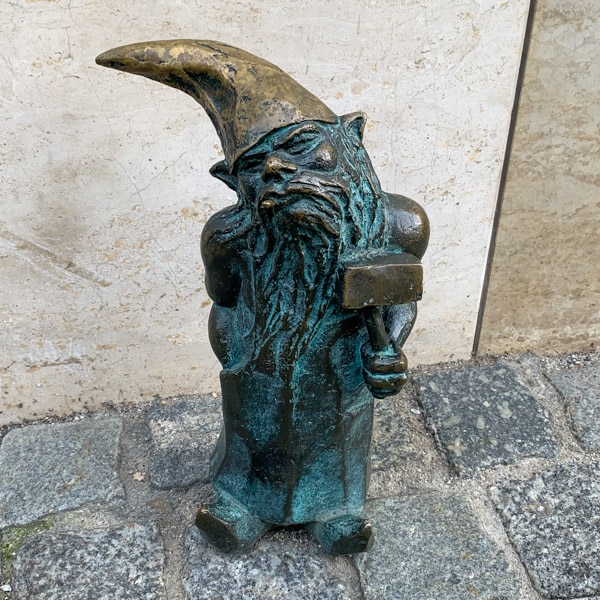
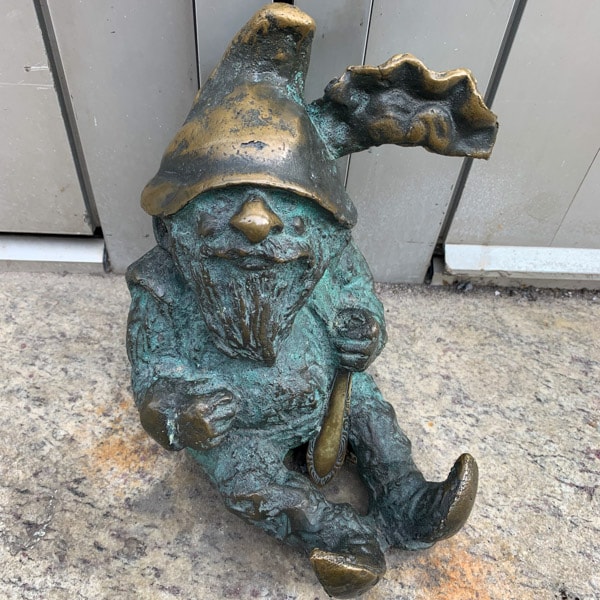
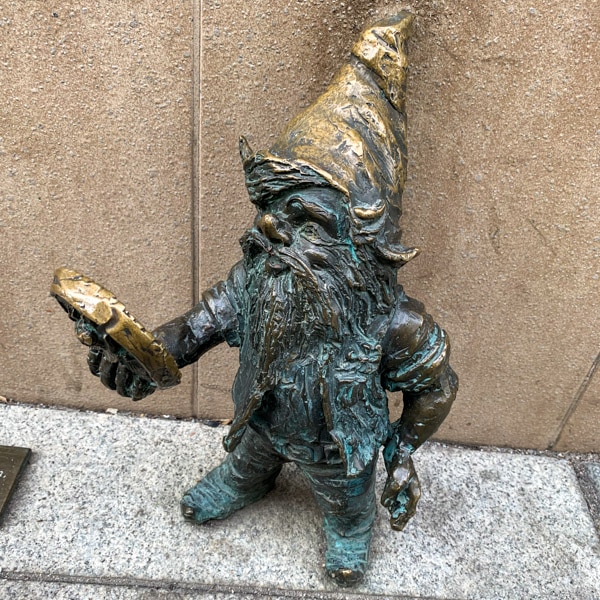
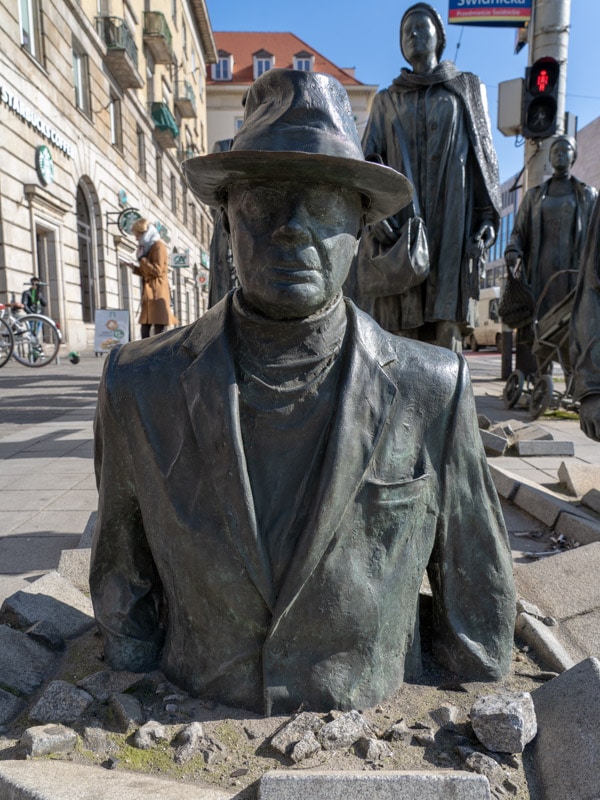
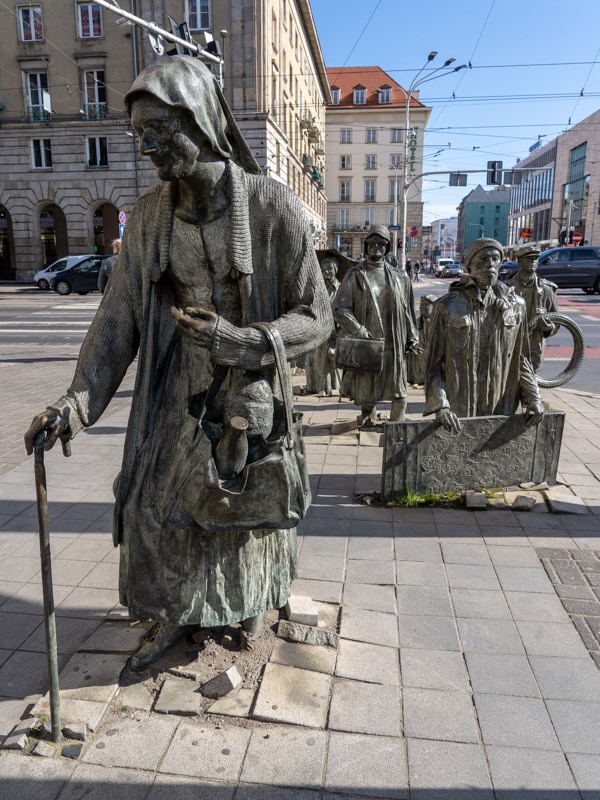
Related Posts